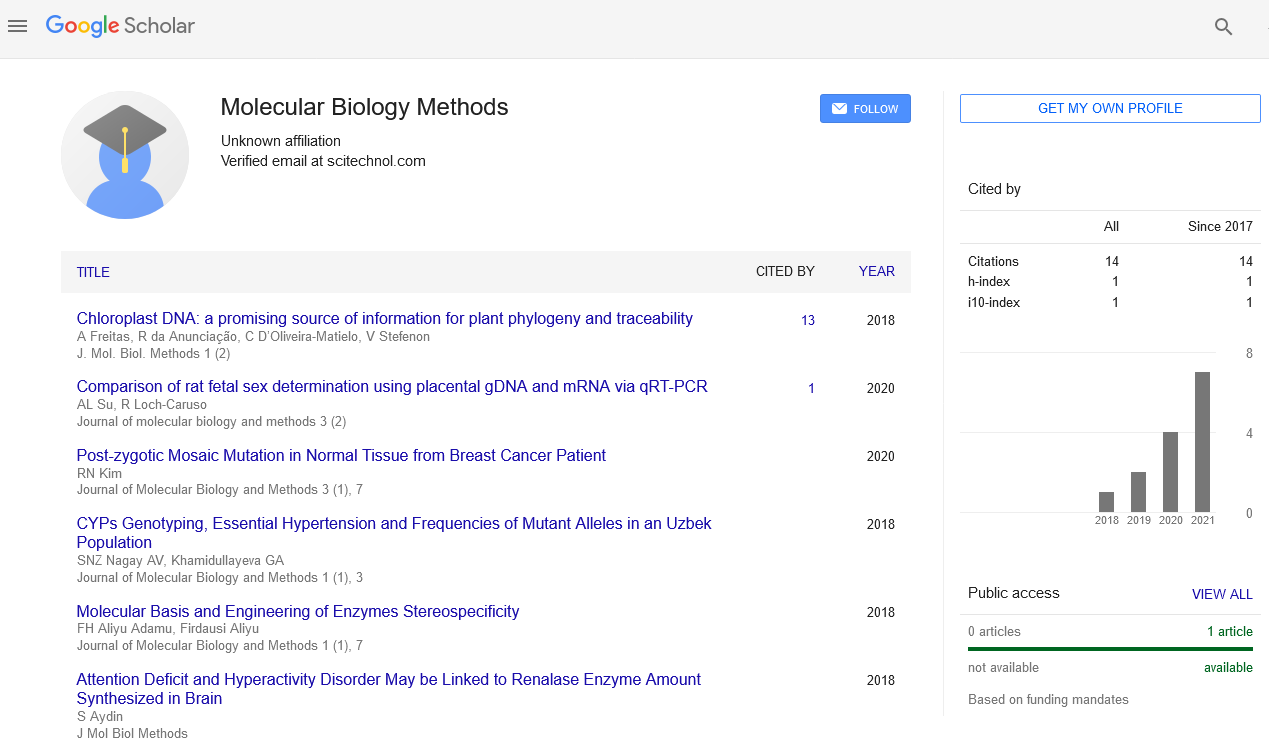Opinion Article, J Mol Biol Methods Vol: 5 Issue: 1
Applications of Genomics in Molecular Biology
Gary J Nabel*,
Howard Hughes Medical Institute, University of Michigan Medical Center, Departments of Internal Medicine and Biological Chemistry, 1150 W. Medical Center Drive, 4520 MSRB I, Ann Arbor, MI 48109-0650, USA
Corresponding Author:
Gary J Nabel
Howard Hughes Medical Institute, University of Michigan Medical Center, Departments of Internal Medicine and Biological Chemistry, 1150 W. Medical Center Drive, 4520 MSRB I, Ann Arbor, MI 48109-0650, USA
E-mail: gnabeljga@umich.edu
Received date: December31, 2021, Manuscript No. JMBM-22-59445;
Editor assigned date: January 03, 2022, Manuscript No. JMBM-22-59445;
Reviewed date: January 13, 2022, Manuscript No. JMBM-22-59445;
Revised date: January 24, 2022, Manuscript No. JMBM-22-59445 (R);
Published date: January 31, 2022, DOI:10.4172/JMBM.1000110
Keywords: Genomics, Genetic Screening, Organic frameworks
Introduction
Genomics is an interdisciplinary area of science zeroing in on the design, work, development, planning, and altering of genomes. A genome is a life form's finished arrangement of DNA, including each of its qualities along with its progressive, three-layered primary configuration. Rather than hereditary qualities, which alludes to the investigation of individual qualities and their jobs in legacy, genomics focuses on the aggregate portrayal and measurement of every one of a living being's qualities, their interrelations and effect on the organism. Genes might coordinate the development of proteins with the help of catalysts and courier particles. Thusly, proteins make up body constructions, for example, organs and tissues as well as control substance responses and convey signals between cells. Genomics additionally includes the sequencing and investigation of genomes through utilizations of high throughput DNA sequencing and bioinformatics to gather and examine the capacity and construction of whole genomes. Advances in genomics have set off a transformation in disclosure based examination and frameworks science to work with comprehension of even the most intricate organic frameworks, for example, the brain. The field likewise incorporates investigations of intragenomic (inside the genome) peculiarities like epistasis (impact of one quality on another), pleiotropy (one quality influencing more than one characteristic), heterosis (mixture force), and different associations among loci and alleles inside the genome.
Techniques
From the Greek , "quality" (gamma, epsilon, nu, epsilon) signifying "become, make, creation, birth", and ensuing variations: ancestry, beginning, hereditary qualities, genic, genomere, genotype, variety and so forth While the word genome (from the German Genom, credited to Hans Winkler) was being used in English however right on time as 1926, the term genomics seemed to be authored by Tom Roderick, a geneticist at the Jackson Laboratory (Bar Harbor, Maine), over lager at a gathering held in Maryland on the planning of the human genome in 1986 at Following Rosalind Franklin's affirmation of the helical design of DNA, James D. Watson and Francis Crick's distribution of the construction of DNA in 1953 and Fred Sanger's distribution of the Amino corrosive grouping of insulin in 1955, nucleic corrosive sequencing turned into a significant objective of early atomic biologists. In 1964, Robert W. Holley and associates distributed the first nucleic corrosive succession at still up in the air, the ribonucleotide arrangement of alanine move RNA. Extending this work, Marshall Nirenberg and Philip Leder uncovered the trio idea of the hereditary code and had the option to decide the arrangements of 54 out of 64 codons in their experiments. In 1972, Walter Fiers and his group at the Laboratory of Molecular Biology of the University of (Ghent, Belgium) were quick to decide the arrangement of a quality: the quality for Bacteriophage MS2 coat protein. Fiers' gathering developed their MS2 coat protein work, deciding the total nucleotide- succession of bacteriophage MS2-RNA (whose genome encodes only four qualities in 3569 base matches [bp]) and Simian infection 40 of every 1976 and 1978, individually.
Commitments to Genetic Screening and Analysis
Notwithstanding his original work on the amino corrosive grouping of insulin, Frederick Sanger and his partners assumed a vital part in the improvement of DNA sequencing strategies that empowered the foundation of complete genome sequencing projects. In 1975, he and Alan Coulson distributed a sequencing methodology utilizing DNA polymerase with radiolabelled nucleotides that he called the Plus and Minus technique. This elaborate two firmly related strategies that created short oligonucleotides with characterized 3' ends. These could be fractionated by electrophoresis on a polyacrylamide gel (called polyacrylamide gel electrophoresis) and pictured utilizing autoradiography. The system could arrangement up to 80 nucleotides in one go and was a major improvement, however was still extremely difficult. By and by, in 1977 his gathering had the option to grouping the majority of the 5,386 nucleotides of the single-abandoned bacteriophage φX174, finishing the principal completely sequenced DNA-based genome. The refinement of the Plus and Minus strategy brought about the chain-end, or Sanger strategy (see underneath), which shaped the premise of the procedures of DNA sequencing, genome planning, information capacity, and bioinformatic investigation most broadly utilized in the accompanying 25 years of research.
Limitation Fragment Length Polymorphism and RFLP Analysis
Around the same time Walter Gilbert and Allan Maxam of Harvard University autonomously fostered the Maxam-Gilbert technique (otherwise called the compound strategy) for DNA sequencing, including the special cleavage of DNA at known bases, a less proficient method. For their weighty work in the sequencing of nucleic acids, Gilbert and Sanger shared a large portion of the 1980 Nobel Prize in science with Paul Berg (recombinant DNA).
 Spanish
Spanish  Chinese
Chinese  Russian
Russian  German
German  French
French  Japanese
Japanese  Portuguese
Portuguese  Hindi
Hindi 